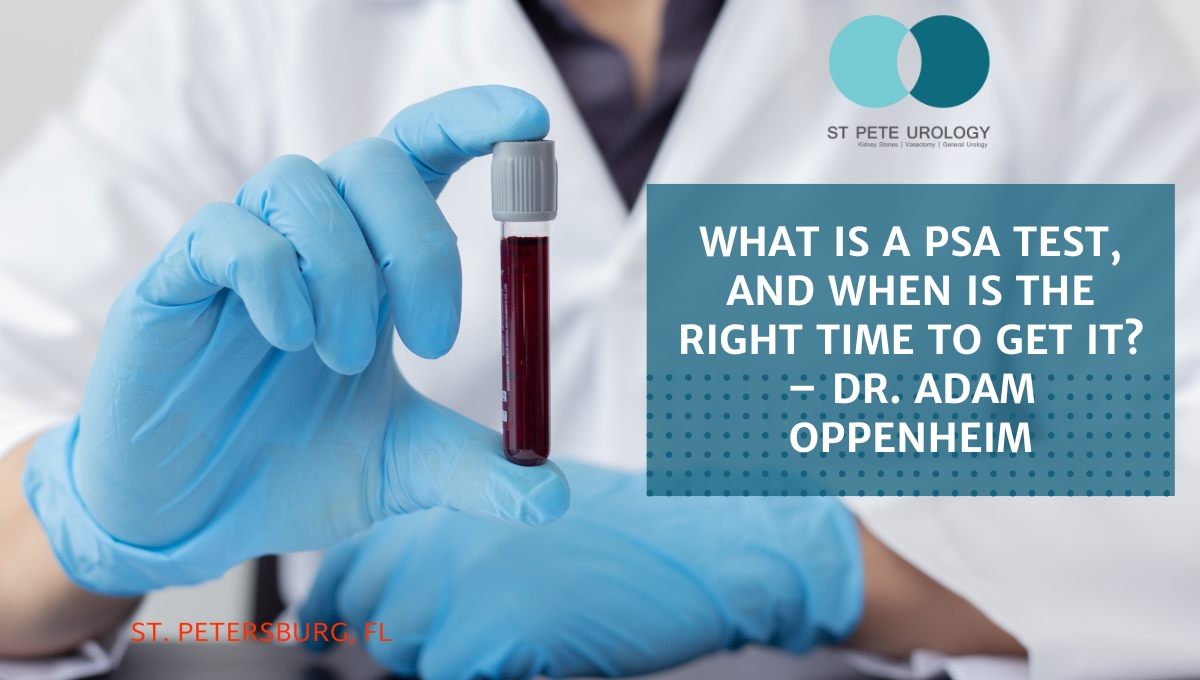Key Takeaways:
- The PSA Test measures the levels of prostate-specific antigen (PSA) in a man’s blood and is used to screen for prostate cancer.
- When to get tested depends on your age and risk factors. For men aged 55-70 without high-risk factors, it is recommended to consider getting a PSA test.
- Early detection of prostate cancer is key to successful treatment, so speaking to your doctor about when to get tested is important in safeguarding your health.
Understanding the PSA Test
Ranked as the second leading cause of cancer deaths in men, prostate cancer demands serious attention. Yet, with early detection, many men can successfully overcome this potentially deadly disease. So, what precisely is a PSA test, and when should you consider undergoing one? Dr. Adam Oppenheim is a distinguished urologist at St. Pete Urology. He offers valuable insights into the significance of this vital diagnostic tool.
“A PSA is a blood test, it stands for the prostate-specific antigen, and it’s a blood test used in the screening of men for prostate cancer.” – Dr. Adam Oppenheim
Unveiling the PSA Test: How it Works
The PSA test measures the levels of prostate-specific antigen (PSA) in a man’s blood. This protein is produced by the prostate gland and is vital for the normal functioning of the prostate. However, elevated levels of PSA can be a red flag, indicating the possible presence of prostate cancer. It is important to note that other factors, such as age, medication, and inflammation, can also affect PSA levels.
When to Get Tested: Age and Risk Factors
The right time to start considering a PSA test largely depends on your age and risk factors. According to Dr. Oppenheim:
“Well, the guidelines recommend that screening for prostate cancer happen between the ages of 55 and 70 unless the patient has significant high-risk factors for prostate cancer, which are family history or being an African American.”
If you fall into this age range and have no high-risk factors, it’s time to think about getting a PSA test. However, if you have a family history of prostate cancer or are of African-American descent, consult your doctor. You should discuss the possibility of earlier screening to ensure proactive health management.
Treatment Options: Surgery vs. Radiation
When your PSA test reveals an elevated level of PSA, your doctor will probably recommend additional tests to confirm the presence of cancer. If cancer is indeed detected, the recommended treatment plan hinges on various factors. These factors include your age, as well as the stage of the cancer. It’s a comprehensive assessment that guides the most appropriate course of action.
“So it largely depends on how old the patient is, a younger patient is likely to be counseled to undergo surgery and have the prostate removed, whereas an older patient is probably more likely to be counseled to undergo radiation where they don’t have to have an inpatient setting of an operation and they can do treatments as an outpatient.” – Dr. Adam Oppenheim
Ultimately, whether you choose surgery or radiation treatment will be a personal decision made in consultation with your doctor.
Taking Control: The Importance of Early Detection
Prostate cancer is a serious medical condition, but with early detection, it can often be successfully treated. By understanding the PSA test and speaking to your doctor about when to get tested, you take an active role in safeguarding your health.
At St Pete Urology, a leading urology practice in St. Petersburg, Florida, their expert team is dedicated to helping you navigate your prostate health journey. From discussing your risk factors to offering guidance on treatment options, St Pete Urology accompanies you every step of the way. Their presence ensures that you receive the best possible care throughout your journey. Don’t leave your prostate health to chance. Reach out to the professionals at St Pete Urology today.
References:
- “Prostate-Specific Antigen (PSA) Test – NCI.” 11 Mar. 2022, https://www.cancer.gov/types/prostate/psa-fact-sheet.
- “What Are The Risk Factors? – Prostate Cancer Foundation.” https://www.pcf.org/patient-resources/family-cancer-risk/prostate-cancer-risk-factors/.
- “Radiation Therapy as Effective as Surgery for Prostate Cancer.” 9 Sep. 2021, https://www.cedars-sinai.org/blog/radiation-therapy-for-prostate-cancer.html.
Transcription:
I’m Dr. Adam Oppenheim, I’m a urologist with St. Pete Urology.
A PSA is a blood test, it stands for the prostate specific antigen, it’s a blood test used in the screening of men for prostate cancer.
Well the guidelines recommend that screening for prostate cancer happen between the ages of 55 and 70, unless the patient has significant high risk factors for prostate cancer, which are family history or being an African American.
So it largely depends on how old the patient is, a younger patient is likely to be counseled to undergo surgery and have the prostate removed, whereas an older patient is probably more likely to be counseled to undergo radiation where they don’t have to have an inpatient setting of an operation and they can do treatments as an outpatient.




